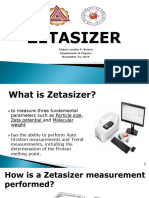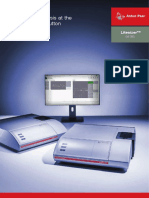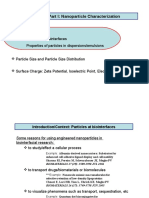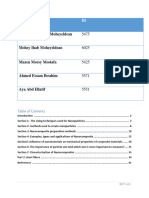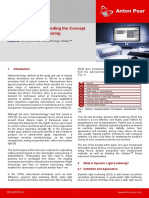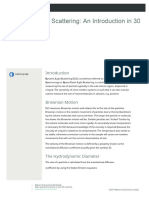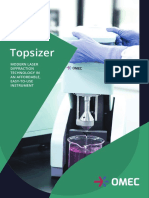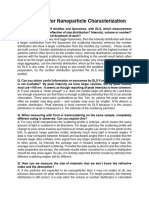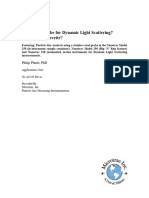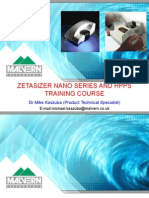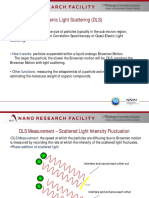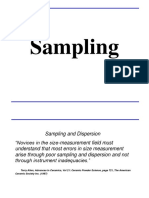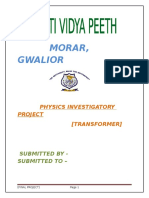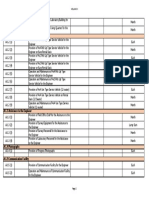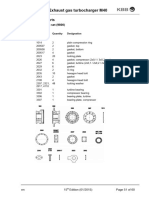Zetasizer Pro and Zetasizer Ultra: Advance With Confidence
Uploaded by
sannintkdZetasizer Pro and Zetasizer Ultra: Advance With Confidence
Uploaded by
sannintkdZETASIZER PRO AND
ZETASIZER ULTRA
ADVANCE WITH CONFIDENCE
2
LIGHT SCATTERING ANALYSIS
FOR YOU
Light scattering is a fundamental analytical technique for the characterization of particulate materials, and is most
commonly applied to colloidal systems, nanoparticles and macromolecules in solution or dispersion, to determine particle
size, molecular weight, or electrophoretic mobility. Different methods of light scattering analysis provide a range of useful
information about your samples:
•• Dynamic Light Scattering (DLS) measures the size and size distribution of molecules and particles
•• Electrophoretic Light Scattering (ELS) measures the electrophoretic mobility of particles or
molecules in dispersion or solution – this is often converted to a ‘zeta potential’
This data is often critical for establishing and optimizing sample integrity and stability, including the detection of aggregates
or agglomerates. Routine use of light scattering analysis helps speed formulation development, gives greater insight into
stability assessments, and helps elucidate and solve product and process challenges.
“Our Zetasizer has been imperative in allowing me
to analyze my drug-loaded polymeric nanoparticle
formulation batches with consistent results.
The instrument is easy to use and allows for
numerous analytical combinations.“
Jessica Castaneda-Gill
University of North Texas
Health Science Center, USA
3
BIOSCIENCE AND BIOPHARMACEUTICALS
Temperature or pH changes, agitation, The Zetasizer ® range provides rapid
shear, and time all impact the stability of purity and stability screening, and
biological molecules, causing denaturation assists with formulation development
and aggregation, loss of function, and so that processes and products
possibly undesirable immune response, in can be optimized and de-risked
the case of biopharmaceuticals.
PAINTS, INKS AND COATINGS
Paint, ink and coating formulations must be by the Zetasizer instruments, play
stable to keep them in an optimum state important roles in determining a product’s
over time without change or aggregation. properties, such as dispersibility, color,
Particle size and zeta potential, measured strength, finish, durability and shelf life
NANOMATERIALS
Zetasizer measurements of nanoparticle materials may result in novel physical and
size distribution, dispersion properties, chemical properties, such as increased
stability and propensity to aggregate are catalytic activity, improved solubility or
crucial to the design of new nanomaterials. unexpected optical or toxicological behavior
The very large surface area of such
FOODS AND DRINKS
Zetasizer systems are used to analyze dispersion and emulsion stability in
particle size and zeta potential to improve order to extend product shelf life and
the appearance and taste of foods, improve product performance
drinks and flavorings, and optimize
PHARMACEUTICALS AND DRUG DELIVERY
The correct particle size and zeta potential the stability and quality of dispersions,
can help ensure the production of emulsions and creams, reducing
effective therapeutics, delivered safely. formulation time and speeding new
Zetasizer systems are used to characterize products to market
ACADEMIA
The Zetasizer is an essential analytical tool covered by Zetasizer systems, coupled with
for many academic laboratories worldwide, tens of thousands of scientific citations,
finding use in all applications where particle have earned these instruments a central
or molecular size and zeta potential analysis space in many scientific faculties.
is required. The breadth of applications
CONSUMER PRODUCTS
Improving many consumer goods particle size and charge on cosmetic
requires understanding and control of the and detergent performance. Zetasizer
colloidal parameters guiding interparticle instruments characterize micellar
interactions and influencing product size, charge, and the critical micelle
stability and performance. An example concentration of surfactants, and measure
is the impact of micelle and emulsion the size and stability of emulsions
4
WHY USE LIGHT SCATTERING?
There are various types of light scattering, The frequency and intensity of the scattered
each designed to provide useful and light can be measured to determine
actionable physicochemical information the size and charge of materials. This
on the sample being analyzed. information is commonly used to shorten
development time for, and improve the
The Zetasizer Pro and Zetasizer Ultra both
stability of, colloidal (including protein)
offer two types of light scattering technology
and emulsion formulations, and to assess
as standard: dynamic light scattering (DLS)
the levels of aggregation in a system.
and electrophoretic light scattering (ELS).
Dynamic Light Scattering (DLS) Non-Invasive Back-Scatter (NIBS)
Dynamic light scattering is a well-established technique Zetasizer systems include NIBS TM technology, which
for measuring the size and size distribution, typically in combines back-scatter detection with variable
the submicron range, of molecules and particles which are measurement positioning and high efficiency fiber optic
dispersed or dissolved in a liquid. The Brownian motion technology. This significantly increases the range of
of these particles or molecules causes the intensity of the sample concentrations and sizes that can be measured,
light they scatter to fluctuate rapidly. Analysis of these compared to conventional DLS.
short-term intensity fluctuations yields the speed of the
Brownian motion and hence the particle size, using the
Stokes-Einstein relationship.
DLS is a highly flexible sizing method which is rapid,
accurate and repeatable. It requires only small volumes
of sample for analysis, and is non-destructive. DLS is
material-independent and therefore widely applicable.
5
“The Zetasizer is such an easy system to
use for the analysis of low volumes of
nanoparticles in various dispersants for
size and zeta potential measurements.
The various cells are easy to use and
cover all applications. The auto-titration
unit is also very efficient at producing pH,
isoelectric and titration results. Malvern
Panalytical customer support is just
an email away when help or service is
needed. This is one of the most used
and valued particle analyzers in our lab!”
Corine Goodrich
Pace Analytical Services Inc.,
Minneapolis, USA
Electrophoretic Light Scattering (ELS)
Electrophoretic Light Scattering measures the The use of ELS commonly relates to stability and
electrophoretic mobility of particles in dispersion or formulation applications. Particles or molecules with
molecules in solution. This mobility is often converted no net charge may bind together, which may be a
to zeta potential to enable the comparison of challenge in systems such as protein formulations
materials under different experimental conditions. which are prone to aggregation. Particles or molecules
which have either a net positive or net negative charge
ELS combines light scattering with electrophoresis.
will better maintain a distance from one another,
A dispersion is introduced into a cell containing two
creating a stable system. The formulation containing
electrodes. An electrical field is applied across the
these particles or molecules is very influential on their
electrodes, and any charged particle or molecule will
charge state, and changes to formulation attributes
migrate towards its oppositely-charged electrode with
such as pH , additive concentration and ionic strength
a velocity which is dependent upon its charge. The
can impact product stability and shelf life.
measured electrophoretic mobility is normally converted
into zeta potential using established theories.
6
DESIGN
MATTERS
The Zetasizer Ultra and Zetasizer Pro have
recently been awarded a prestigious Red Dot
Design Award, emerging as winners from
a wide variety of products in 48 different
categories from designers and manufacturers
across the globe. This international
distinction is one of the most sought-after
seals of quality for good product design.
The Zetasizer Ultra and Zetasizer Pro reflect and
contemporize the values and heritage of Malvern
Panalytical’s flagship Zetasizer Nano range,
upon which the technology of these enhanced
next generation instruments is based. The
instruments’ new form, incorporating the highest
quality materials and refined interface, conveys
an assured expertise consistent with their unique
enhanced capabilities, helping the user focus
on the specifics of the sample measurement
in order to deliver more accurate results.
7
A FOUNDATION OF
EXCELLENCE
Pioneer technologists at the heart of Malvern Panalytical The technique of Photon Correlation Spectroscopy
were pivotal to the commercial development of light (PCS), more commonly known as Dynamic Light
scattering methods for particle size analysis. Scientists Scattering (DLS), continued to evolve, with Malvern
at the Royal Signals and Radar Establishment (RSRE, Instruments’ first integrated measurement system, the
Malvern, UK), applied digital correlation techniques Autosizer, appearing on the market by the late 1970s.
to analyze the scattering from particles undergoing The subsequent development of Electrophoretic Light
Brownian motion. This led to the development in late Scattering (ELS) by Malvern Instruments in the early 1980s
1971 of the world’s first commercial correlator, and to resulted in the world’s first integrated particle size and
Malvern Instruments and RSRE being jointly awarded the zeta potential measurement system, the Zetasizer 2.
prestigious MacRobert engineering award for Outstanding
In 2003, the Zetasizer Nano family, incorporating patented
Technical Innovation on the 20th December 1977.
non-invasive backscatter (NIBS) technology, was launched.
This instrument had applications in aeronautics, marine NIBS is one of the key features that makes Zetasizer
engineering, fuel performance, and life sciences. Its instruments the best-in-class, enabling the ultimate in
key application was measuring the size distribution of instrument flexibility by maximizing the dynamic range
particles in suspension or macromolecules in solution, without compromise, providing the highest sensitivity
by measuring the diffusion coefficient of the scattering whilst handling the most concentrated samples, and
entities. Quoting the MacRobert Award Evaluation measuring the very smallest particles as well as the
Committee, responsible for choosing the recipients of the very largest. It is the accessibility, versatility and ease
award, “The Malvern Correlator provides an outstanding of use of this range of instruments that has made
example of the way in which advanced scientific principles light scattering an analytical mainstay for applications
can be allied to the latest technological developments to ranging from ink manufacture to drug delivery.
provide equipment of practical and commercial value.”
Publications referencing Zetasizer
Today, the design award-winning 18000
Zetasizer Pro and Zetasizer Ultra
continue the legacy of Malvern 16000
Panalytical’s pioneering scientists
Number of publications per year
14000
from the 1960s and ‘70s, building
on this strong foundation and 12000
incorporating the very latest
advances in hardware, software, 10000
technology and intelligence. With
more than 80,000 scientific citations 8000
to date, it is clear that Zetasizer
6000
systems bring value across a
broad spectrum of industrial and
4000
academic sectors, where they are
widely used to speed and optimize 2000
both processes and products.
0
1980 1985 1990 1995 2000 2005 2010 2015 2020
Year
Data from Google Scholar, accessed 24th April 2018
8
ZETASIZER PRO
Fast
The Zetasizer Pro is a robust and versatile solution
for routine laboratory measurements of molecular
size, particle size, electrophoretic mobility and zeta
potential. Size measurements can now be performed
more than twice as quickly, compared to previous
models, accelerating sample throughput and freeing up
operator and system time for other tasks.
Simple
ZS Xplorer software is designed to simplify
and automate even complex analysis, allowing
challenging measurements to be completed
without expert knowledge. Its unique sample-
centric workflow delivers the ultimate in usability
and flexibility, meaning it’s faster and easier than
ever to get from sample input to result output.
Intelligent
A common challenge with light scattering
is dust contamination – this can now be
intelligently identified and filtered from
the data. It’s also immediately apparent if
results aren’t quite as expected and need
a little more attention. Integrated deep-
learning empowered data quality guidance
offers instant feedback, flagging any
queries and providing actionable advice
on how to improve lower quality data.
Optical filters
Both the Zetasizer Pro and the Zetasizer Ultra incorporate an optical
filter wheel allowing NIBS size measurements to be made with either
a fluorescence filter or horizontal and vertical polarizers in the detector
path, if desired. The fluorescence filter allows users to measure previously
challenging fluorescent samples by blocking emissions from fluorescence
to improve signal-to-noise. The polarizers allow users to explore the effect of
polarization on their samples and make depolarized DLS measurements.
9
ZETASIZER PRO KEY FEATURES AND BENEFITS
•• Dynamic Light Scattering (DLS) measures particle •• Adaptive Correlation enables the software to determine
and molecule size, from below 1 nm to 10 µm optimum measurement duration, and identifies data
associated with transient artefacts. Reliable and
•• Electrophoretic Light Scattering (ELS) measures the
repeatable data is produced over twice as quickly,
zeta potential of particles and molecules, indicating
providing a truly representative view of the sample
sample stability and/or propensity to aggregate
•• Sample-centric ZS Xplorer software enables flexible, •• NIBS (Non-Invasive Back-Scatter) technology
maximizes the dynamic range, providing the highest
guided use, and provides assistance as required
sensitivity for even the most concentrated samples
•• The deep-learning empowered Data Quality System
assists users in understanding which of their size data •• M3-PALS with Constant Current Mode
measures electrophoretic mobility and zeta
might be poor, and why. This intelligent neural network
potential in high conductivity media – reducing
system also suggests how to improve results, helping
errors that can be associated with electrode
less-experienced users generate excellent quality data
polarization at higher ion concentrations
•• Optical filter wheel offers a fluorescence filter and both
vertical and horizontal polarizers for analytical flexibility
10
ZETASIZER ULTRA
Advanced
The Zetasizer Ultra is the ultimate companion for fast yet
accurate particle and molecule sizing, particle charge and
particle concentration measurements, and represents the
most intelligent and flexible instrument in the Zetasizer range.
This powerful system has the unique capacity to perform
calibration-free particle concentration measurements
with ease, even deep into the nano size range.
Assured
Alongside Malvern Panalytical’s NIBS (Non-Invasive
Back-Scatter) technology, the Zetasizer Ultra offers
Multi-Angle Dynamic Light Scattering (MADLS®).
This ground-breaking technique provides high resolution
angle-independent size measurements, meaning no more
worry about missing particles in your sample. With MADLS,
you can be sure that all angles are simultaneously covered.
Expert
Pushing the upper analytical size range higher than
ever before, the Zetasizer Ultra is designed to provide
data you can trust to help you make those important
decisions to improve your products and processes.
Despite its unique capabilities, the Zetasizer Ultra’s
speed and ease-of-use are uncompromised,
making it by far the most advanced and
powerful light scattering system available.
“The Zetasizer is an excellent
instrument for the study of
particle size and charge. It is quick
and easy to use and reliable in terms
of the repeatability of results. I cannot
imagine trying to complete my nanoemulsion
project without it.”
Kunal Kadiya
University of Saskatchewan Canada
11
ZETASIZER ULTRA KEY FEATURES AND BENEFITS
•• Multi-Angle Dynamic Light Scattering (MADLS) for high •• NIBS (Non-Invasive Back-Scatter) technology maximizes
resolution angle-independent size measurements offers the dynamic range, providing the highest sensitivity for
greater insight into the size distribution of your sample even the most concentrated samples
•• Disposable capillary sizing cell provides the ultimate in •• The deep-learning empowered Data Quality System
non-destructive, low volume (down to 3 µL) analysis, with assists users in understanding which of their
an upper size range that extends to 10 µm size data might be poor, and why. This intelligent
neural network system also suggests how to
•• Simple, calibration-free measurement of particle
improve results, helping even less-experienced
concentration in homogeneous sample types, covering a
users generate excellent quality data
wide range of materials
•• Electrophoretic Light Scattering (ELS) measures the zeta •• Adaptive Correlation produces reliable and repeatable
data over twice as quickly, providing a truly representative
potential of particles and molecules, indicating sample
view of the sample
stability and/or propensity to aggregate
•• Sample-centric ZS Xplorer software enables flexible, •• M3-PALS with Constant Current Mode measures
electrophoretic mobility and zeta potential in high
guided use, and the capability to build complex methods
conductivity media
with ease
•• Optical filter wheel offers a fluorescence filter and both
vertical and horizontal polarizers for analytical flexibility
12
ZS XPLORER SOFTWARE –
RESULTS YOU CAN SIMPLY TRUST
Even the most advanced instruments need user-friendly, The method can be duplicated for the next sample in
intelligent software to produce the best results. We’ve the run, after entering a new sample name. For more
rethought and redesigned the new Zetasizer software experienced users, there’s full accessibility to all the
to create a user interface that shows our world-leading method and data parameters .
light scattering technology at its finest. This new Zetasizer
We’ve made it easier to set up methods in advance and to
software package is named ZS Xplorer.
combine methods for different measurement types. The
ZS Xplorer is sample-centric. Information on the sample, live measurement display appears alongside the method
its conditions, and the variables to be tested are entered builder, enabling the user to set up the next sample during
at the beginning of a run, and ZS Xplorer uses this a measurement run. In addition, ZS Xplorer will detect
information intelligently to optimize the method for that potential problems with an experiment, such as cuvette
sample. It’s as simple as adding a sample name, choosing incompatibility, and will provide a warning before the
a cell type and a measurement type, and pressing ‘play’. analysis begins.
EXPERT GUIDANCE FOR TRUE DATA QUALITY
DLS can be affected by the presence of large aggregates or by multiple scattering at
high concentrations, complicating data interpretation. The quality guidance system in
ZS Xplorer intelligently applies its integrated expert knowledge to rapidly indicate the
quality of data. When the guidance system detects poorer quality data, the interface will
provide information about why this may have happened, and actionable advice on how
to improve the measurement or the sample.
This feature is particularly useful for less-experienced users and for those analyzing
new sample types, providing confidence that the data delivered can be depended upon.
13
MORE INTELLIGENT DATA,
DELIVERED FASTER
ZS Xplorer features a new algorithm called Adaptive Adaptive Correlation intelligently identifies rogue large
Correlation that uses information from the sample particles and filters these from the presented data, but
to determine how long it should be measured for, retains populations which are consistently present. This
collecting data until the final answer has become reduces the technique’s sensitivity to occasional events
consistent. This feature also applies intelligent logic and provides a more representative view of the sample.
to separate erroneous data associated with transient
Adaptive Correlation delivers reliable and repeatable
artefacts such as dust or aggregates, which may
data over twice as fast as ever before.
previously have required diagnosis by an experienced
user followed by additional sample preparation.
CUSTOMER STORY
Aqdot® is a Cambridge (UK)-based performance and simple, particularly when it came to building and
chemistry company with expertise in developing, modifying complex methods. The scientists especially
licensing and selling novel proprietary products. One of valued the ability to obtain time-resolved data describing
their current projects is focused on the development the properties of nanoparticles over timescales of
and optimization of polymeric nanoparticles for a few seconds to several days, with the short-time
pharmaceutical delivery applications. Particle size measurements benefiting from the new shorter
and zeta potential are key attributes measured by the acquisition time capability and Adaptive Correlation
Zetasizer Ultra which help determine this product’s feature. They appreciated the ability to analyze results
stability and efficacy. and create methods whilst the instrument was collecting
new data. In addition, during data analysis, the ability to
Aqdot’s scientists found the new ZS Xplorer software
select multiple records and overlay results made data
to be user-friendly, saving them a significant amount of
comparison easy, speeding interpretation.
analysis time. They reported finding the platform intuitive
14
MADLS – ULTIMATE CONFIDENCE IN YOUR
SIZE MEASUREMENTS
MADLS, or Multi-Angle Dynamic Light Scattering, is
a revolutionary technology developed by Malvern
Panalytical specifically for the Zetasizer Ultra. Within as
little as three minutes, MADLS automatically performs
a full analysis of your sample at multiple light scattering
angles, so that each particle is analyzed robustly with no “I found the new ZS Xplorer
particle size bias. All data collected is auto-compiled into
software intuitive and easy to
a single integrated measurement, providing a thorough
and dependable picture of your sample , independent of use. It is very simple to set up
measurement angle. a project folder, and the search
MADLS helps resolve size populations that may previously and navigation tools within
have been obscured by larger particles, reducing the
need for further characterization by complementary
the file system are excellent.
techniques. This groundbreaking technology quickly and
simply automates the entire process of performing a All that’s needed to run an
multiple-angle size measurement, eliminating confusing analysis is a sample name,
manual data interpretation. MADLS provides the ultimate
in particle size resolution throughout your sample, and
cell type, and some basic
gives you confidence in every measurement you make. measurement parameters.“
Stuart Reynolds
Domino Printing Sciences
Cambridge, UK
Pushing the limits of particle
concentration measurement
Another unique capability of the Zetasizer Ultra enabled by
MADLS technology is the calibration-free measurement of particle
concentration. This provides a truly representative picture of the
sample, unaffected by angular sensitivity, with an increased capability
to resolve individual populations. In a sample volume as low as 20 µL,
nanoparticles, protein molecules and other particles as small as
1 nm can now be measured in terms of their concentration, allowing
you to understand whether these populations are significant.
Particle concentration can be measured with little or no
sample dilution, minimizing the risk of introducing dilution
effects and errors. The technique is equally applicable to
monodisperse and polydisperse samples, and is able to resolve
the individual concentrations of different size populations.
15
WHAT DOES THIS MEAN FOR YOU?
Simple, sample-centric ZS Xplorer software ensures Sample preparation now requires less stringency, and
that the Zetasizer Pro and Zetasizer Ultra can be used DLS size measurements can be performed in less than
by people at all levels of experience. There is no longer half the time they previously took. The quality of data is
any need for users to be light scattering experts, and increased due to intelligent algorithms that recognize
everyone can perform quick and easy, yet highly accurate sample artefacts. Together, this means that confidence
experiments. in reporting the correct result, even for complex, multi-
measurement methods, is improved whilst keeping
measurement durations to a minimum.
The impact of these developments is wide-reaching:
•• The ease and speed of analysis increases laboratory throughput,
freeing time on the instrument for other projects
•• Generation of excellent quality data, even by inexperienced
users, frees more senior scientists for more complex work
•• Actionable advice means studies are completed more quickly,
with less data interpretation and troubleshooting required
•• Consistency of results means less repetition of analysis, saving both
sample material and costs, and increasing study impact and integrity
•• Confident and quick evidence-based decisions can be made
on the next steps to improve products and processes
CUSTOMER STORY
Particle Works, a Blacktrace Holdings Ltd. brand based in Royston, UK, develops and manufactures high
performance, cutting edge nanoparticles and microparticles for use in applications including bio-imaging, targeted drug
delivery, and controlled drug release.
The brand is known for its high-performance, monodisperse particles, so precise analysis of size, shape and structure is
key within both R&D and QC. Transmission electron microscopy (TEM) has traditionally been used by Particle Works for
particle sizing and morphological analysis. However, TEM is an expensive, low-throughput and time-consuming technique,
which relies on user expertise, and is not applicable for use with every material. In addition, TEM can only measure a small
proportion of a sample during each analysis, which calls for an orthogonal technique to verify the whole sample state.
Using the Zetasizer UItra, the Particle Works team found that using MADLS with Adaptive Correlation data filtering has:
•• Dramatically increased sample throughput and sped up the R&D build-measure-learn cycle
•• Accelerated the particle development cycle from 12 months to approximately one month
•• Enabled the analysis of whole samples, determining true particle size distributions
•• Increased the self-reliance of R&D and Production personnel
•• Substantially decreased the cost of development, due to reduced reliance on TEM
16
ACCESSORIES
Disposable folded capillary cell
(Pro and Ultra)
A disposable capillary cell which enables contamination-free, high accuracy size, zeta potential and
protein mobility measurements in as little as 20 µL of sample. The new capillary shape provides
improved repeatability along with enhanced thermal performance for high conductivity samples, to
reduce Joule heating. Although disposable, each cell can be used for hundreds of measurements of
low conductivity samples if desired. This cell is not suitable for use with MADLS , but can be used for
NIBS and forward scatter size measurements
Low volume disposable sizing cell
(Ultra)
A very low volume (minimum 3 µL) disposable sizing cuvette
which extends the size measurement range for the Zetasizer
without density-matching of the dispersant.
This cell enables repeatable analysis even at ultra-low sample
volumes, delivering high quality data whilst reducing cost.
This cuvette is not suitable for use with MADLS
17
ACCESSORIES
Universal ‘dip’ cell kit
(Pro and Ultra)
A solvent resistant cell for the measurement of zeta potential of samples in
aqueous and non-aqueous dispersants, designed to be cleaned and reused.
The ‘dip’ cell kit can be used with standard polystyrene or glass cuvettes
High concentration zeta potential cell kit
(Pro and Ultra)
This high concentration cell enables measurement of the zeta
potential of samples with little or no dilution required
12 mm square glass cuvette
(Pro, Ultra)
This glass cuvette is compatible with both aqueous and non-aqueous solvents and
dispersants, and is used for size measurements, including those performed with
MADLS. It can also be used for particle concentration measurements.
Low-volume quartz cuvette
(Pro, Ultra)
This quartz cuvette holds between 12 µL and 45 µL of sample and is used for size
measurements. It is compatible with both aqueous and non-aqueous solvents and
dispersants, and can be used for MADLS and particle concentration measurements
12 mm glass cell
(Pro, Ultra)
A glass cuvette used for size and zeta potential measurements using the ‘dip’ cell.
This cuvette is compatible with both aqueous and non-aqueous solvents and
dispersants, and can be used for MADLS and particle concentration measurements
12 mm square polystyrene cuvette
(Pro, Ultra)
A disposable polystyrene cuvette for size measurements, and also for zeta potential
measurements when used with the ‘dip’ cell. This cuvette is typically used for samples
where cross-contamination might be an issue and can be used for MADLS and particle
concentration measurements
Disposable micro-cuvette
(Pro and Ultra (NIBS only))
This disposable plastic micro-cuvette holds a maximum sample volume of 40 µL
and is compatible with both aqueous and non-aqueous solvents and dispersants.
It is used for size measurements using NIBS. It is not suitable for MADLS or particle
concentration measurements.
18
ACCESSORIES
MPT-3 Autotitrator
(Pro and Ultra )
A cost-effective accessory designed to automate
the measurement of size and zeta potential
as a function of pH, with new algorithms
to improve point spacing precision
SV-10 Viscometer
(Pro and Ultra)
The SV-10 is an extremely simple and rapid system
which accurately measures viscosity for the conversion
of diffusion speed to size, and electrophoretic mobility
to zeta potential. This is a standalone accessory that is
particularly useful for complex dispersants for which there
are no available standard literature values for viscosity
19
PRODUCT SPECIFICATIONS AT A GLANCE
Parameter Zetasizer Pro Zetasizer Ultra
Size
Measurement techniques Dynamic light scattering (Non- Dynamic light scattering (Non-Invasive Back-Scatter (NIBS)
Invasive Back-Scatter - NIBS) Dynamic light scattering (13°, 173°)
Dynamic light scattering (13°, 173°) Multi-Angle Dynamic Light Scattering (MADLS)
Measurement angles 1 173°, 13° 173°, 13°, 90°
Range (diameter) 2 0.3 nm - 10 μm 0.3 nm - 10 μm
Minimum sample volume 12 μL 3 μL
Minimum sample NIBS (173°) 0.1 mg/mL 0.1 mg/mL
concentration3 Forward angle (13°) 10 mg/mL 5 mg/mL
Side angle (90°) N/A 1 mg/mL
MADLS N/A 1 mg/mL
Maximum sample concentration 4,5
40% w/v 40% w/v
Zeta potential
Measurement technique Mixed-mode measurement, phase analysis light scattering (M3-PALS)
Size range suitable for measurement (diameter)2 3.8 nm – 100 μm
Zeta potential range No effective limitations
Mobility range > +/- 20 µ.cm/V.s
Minimum sample volume 6
20 μL
Minimum sample concentration3 10 mg/mL 1 mg/mL
Maximum sample concentration 4,5 40% w/v
Maximum sample conductivity 260 mS/cm
Conductivity accuracy ± 10%
Particle concentration
Concentration range (30 nm gold) N/A 1 x 108 - 1 x 1012 particles/mL
System
Product compliance Product laser class 1, EN 60825-1:2014 and CDRH, LVD, EMC, RoHS
Laser attenuation Automatic, transmission 100% to 0.0003%
Laser Maximum power output 4 mW 10 mW
information Beam wavelength 632.8 nm 632.8 nm
Detector Avalanche photodiode
Condensation control Purge facility using dry air/nitrogen
Temperature control range 7 0°C - 120°C
Dimensions (W x D x H) 322 mm x 565 mm x 245 mm
Weight 19 kg
Power requirements AC 100-240 V, 50-60 Hz, 4.0 A
Power consumption Max. 100 W, 45 W typical
Ambient operating conditions +10°C to +35°C (+50°F to +95°F) 35% - 80% RH (non-condensing)
Computer interface USB 2.0 or higher
Recommended computer specification Windows ® 7 or 10 64bit OS, 4th generation i7 Processor, 8GB physical memory and
1TB hard drive & DVD Drive
Notes: 1. Water as sample dispersant; 2. Peak mode range (diameter) 0.6 nm - 10 μm; sample & sample preparation dependent ; 3. Measured using 14.3 kDa protein; 4. Sample-
dependent; 5. Measured using bile acid; 6. Using diffusion barrier method; 7. Temperature accuracy 0.1°C at 25°C, 0.2°C at 0°C, 0.5°C at 90°C, 2.5°C at 120°C
WHY CHOOSE SERVICE & SUPPORT
MALVERN PANALYTICAL? Malvern Panalytical provides the global training, service
and support you need to continuously drive your analytical
processes at the highest level. We help you increase the
We are global leaders in materials
return on your investment with us, and ensure that as
characterization, creating superior, customer- your laboratory and analytical needs grow, we are there to
focused solutions and services which supply support you.
of this information and we shall not be liable for errors contained herein or for damages in connection with the use of this material. Malvern Panalytical reserves the right to change the content in this material at any time without notice.
tangible economic impact through chemical,
Disclaimer: Although diligent care has been used to ensure that the information in this material is accurate, nothing herein can be construed to imply any representation or warranty as to the accuracy, correctness or completeness
Our worldwide team of specialists adds value to your
physical and structural analysis. business processes by ensuring applications expertise, rapid
response and maximum instrument uptime.
Our aim is to help you develop better quality • Local and remote support
products and get them to market faster. Our • Full and flexible range of support agreements
• Compliance and validation support
solutions support excellence in research,
• Onsite or classroom-based training courses
and help maximize productivity and process • e-Learning training courses and web seminars
efficiency. • Sample and application consultancy
Malvern Panalytical is part of Spectris,
Copyright: © 2018 Malvern Panalytical. This publication or any portion thereof may not be copied or transmitted without our express written permission. MRK2351-01-EN
the productivity-enhancing instruments and
controls company.
www.spectris.com
MALVERN PANALYTICAL
Grovewood Road, Malvern, Lelyweg 1,
Worcestershire, WR14 1XZ, 7602 EA Almelo,
United Kingdom The Netherlands
Tel. +44 1684 892456 Tel. +31 546 534 444
Fax. +44 1684 892789 Fax. +31 546 534 598
[email protected]
www.malvernpanalytical.com
www.malvernpanalytical.com
You might also like
- 〈1430.4〉 ANALYTICAL METHODOLOGIES BASED ON SCATTERING PHENOMENA-ELECTROPHORETIC LIGHT SCATTERING (DETERMINATION OF ZETA POTENTIAL)No ratings yet〈1430.4〉 ANALYTICAL METHODOLOGIES BASED ON SCATTERING PHENOMENA-ELECTROPHORETIC LIGHT SCATTERING (DETERMINATION OF ZETA POTENTIAL)4 pages
- MATE 280 Characterization of Powders and Porous MaterialsNo ratings yetMATE 280 Characterization of Powders and Porous Materials57 pages
- Malvern_Panalytical_Zetasizer_Advance_Brochure_PN13647_BRNo ratings yetMalvern_Panalytical_Zetasizer_Advance_Brochure_PN13647_BR5 pages
- Brochure Nicomp n3000 Dynamic Light Scattering Particle Size Analyzer 10438No ratings yetBrochure Nicomp n3000 Dynamic Light Scattering Particle Size Analyzer 104386 pages
- Equipment: Zeta Potential Analyzer (DLS) / LitesizerNo ratings yetEquipment: Zeta Potential Analyzer (DLS) / Litesizer6 pages
- Your Solution: For Nanoparticle Sizing and Zeta Potential MeasurementsNo ratings yetYour Solution: For Nanoparticle Sizing and Zeta Potential Measurements8 pages
- 〈1430.4〉 Analytical Methodologies Based on Scattering Phenomena - Electrophoretic Light Scattering (Determination of Zeta Potential)No ratings yet〈1430.4〉 Analytical Methodologies Based on Scattering Phenomena - Electrophoretic Light Scattering (Determination of Zeta Potential)4 pages
- Lecture 3.2 - Introduction To The Synthesis of Nanomaterials - DLS and ZetaNo ratings yetLecture 3.2 - Introduction To The Synthesis of Nanomaterials - DLS and Zeta48 pages
- 6. Determine the Particle Size of Given Sample Using a Zetasizer Particle Size AnalyserNo ratings yet6. Determine the Particle Size of Given Sample Using a Zetasizer Particle Size Analyser4 pages
- Microtrac Dynamic Light Scattering Particle SizersNo ratings yetMicrotrac Dynamic Light Scattering Particle Sizers7 pages
- PSS Application Note 748 Dispersion StabilityNo ratings yetPSS Application Note 748 Dispersion Stability3 pages
- A Practical Guide To Nanoparticle Characterization by Light Scattering TechniquesNo ratings yetA Practical Guide To Nanoparticle Characterization by Light Scattering Techniques124 pages
- BR Assets Zetasizer Nano Basic Guide English Man0486 02 en Tcm55 11628No ratings yetBR Assets Zetasizer Nano Basic Guide English Man0486 02 en Tcm55 1162882 pages
- tn220915-zeta-potential-method-development-ENNo ratings yettn220915-zeta-potential-method-development-EN10 pages
- Particle Analysis at The Touch of A Button: Litesizer™No ratings yetParticle Analysis at The Touch of A Button: Litesizer™12 pages
- Outline For Part I: Nanoparticle CharacterizationNo ratings yetOutline For Part I: Nanoparticle Characterization36 pages
- Application Report: White Paper: Understanding The Concept of Dynamic Light ScatteringNo ratings yetApplication Report: White Paper: Understanding The Concept of Dynamic Light Scattering9 pages
- DynamicLightScatteringIntroduction 6 - tcm50 37023No ratings yetDynamicLightScatteringIntroduction 6 - tcm50 3702317 pages
- Wet or Liquid Dispersion Method Development For Laser Diffraction Particle Size Distribution MeasurementsNo ratings yetWet or Liquid Dispersion Method Development For Laser Diffraction Particle Size Distribution Measurements9 pages
- CHM4400 Advanced Analytical Chemistry: Particle Size AnalysisNo ratings yetCHM4400 Advanced Analytical Chemistry: Particle Size Analysis16 pages
- DTS Nano Series Training Course Size DayNo ratings yetDTS Nano Series Training Course Size Day98 pages
- The Effects of Particle Size Distribution On The Properties of Medical Materials With LicenseNo ratings yetThe Effects of Particle Size Distribution On The Properties of Medical Materials With License8 pages
- MATE 280 Characterization of Powders and Porous Materials100% (1)MATE 280 Characterization of Powders and Porous Materials65 pages
- Characterization of Powders, Porous Solids and SuspensionsNo ratings yetCharacterization of Powders, Porous Solids and Suspensions57 pages
- Dynamic Light Scattering (DLS) : What's It ForNo ratings yetDynamic Light Scattering (DLS) : What's It For10 pages
- tn240126-zetasizer-lab-blue-for-water-treatment-ENNo ratings yettn240126-zetasizer-lab-blue-for-water-treatment-EN2 pages
- Characterization Techniques For NanoparticlesNo ratings yetCharacterization Techniques For Nanoparticles8 pages
- Whitepaper Nanoparticles Drive Nanotech Revolution 10709No ratings yetWhitepaper Nanoparticles Drive Nanotech Revolution 107096 pages
- HORIBA - A Guidebook To Particle Size Analysis - 2022No ratings yetHORIBA - A Guidebook To Particle Size Analysis - 202236 pages
- Thermoelectric Effect Peltier Seebeck and Thomson: March 2020No ratings yetThermoelectric Effect Peltier Seebeck and Thomson: March 202013 pages
- Formulation Strategies For Enhancing The Bioavailability of Silymarin: The State of The ArtNo ratings yetFormulation Strategies For Enhancing The Bioavailability of Silymarin: The State of The Art29 pages
- BVF3184 Topic 4 Part 1 - Boiler ComponentsNo ratings yetBVF3184 Topic 4 Part 1 - Boiler Components44 pages
- Edible Nanofiller For Development of Edible Bio-Nanocomposite Film: A ReviewNo ratings yetEdible Nanofiller For Development of Edible Bio-Nanocomposite Film: A Review18 pages
- CTIS 310 - MP1 - Strong Password GeneratorNo ratings yetCTIS 310 - MP1 - Strong Password Generator3 pages
- Presented by Mark Jigger O. Villanueva Instructor - GE007No ratings yetPresented by Mark Jigger O. Villanueva Instructor - GE00720 pages
- Basic Thermodynamics Revision Part 1+ 2 Marut TiwariNo ratings yetBasic Thermodynamics Revision Part 1+ 2 Marut Tiwari56 pages
- DO - 143 - s2017 Standard Pay Items PART 2No ratings yetDO - 143 - s2017 Standard Pay Items PART 21 page



